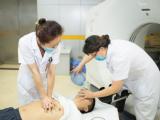May 10, 2004 (CIDRAP News) Chinese researchers have found the SARS (severe acute respiratory syndrome) coronavirus (SARS-CoV) in the intestinal tract, sweat glands, and kidneys of SARS victims, suggesting that food, sweat, and body wastes could spread the virus.
SARS is mainly associated with the respiratory tract and is believed to spread primarily through droplets from coughing and sneezing. But researchers writing in the Journal of Pathology report they found the virus in many other organs.
The researchers, from First Military Medical University in Guangzhou, China, analyzed autopsy samples of numerous organs from four patients who had died of SARS and four patients who had died of other diseases.
To identify the virus, the investigators used an immunohistochemistry technique involving a mouse monoclonal antibody that binds to a specific SARS virus protein. They also used reverse-transcriptase polymerase chain reaction and "in situ hybridization" to amplify and reveal other fragments of the virus.
As expected, the virus was most abundant in the lungs, with 50% to 74% of cells infected in all four patients. In most of the patients, the virus was found in 25% to 49% of kidney, adrenal, sweat gland, and parathyroid cells. Smaller percentages of cells in the pituitary gland, liver, cerebrum, and pancreas were infected. No virus was identified in the esophagus, thyroid gland, spleen, lymph nodes, bone marrow, testis, ovary, uterus, heart, aorta, cerebellum, or muscles.
In the gastrointestinal tract, the virus was found in epithelial cells, a finding also seen in one previous study. "This suggests that the gastrointestinal system may also be an entry route for SARS-CoV present in food or water," the authors write. Although there is no direct evidence that this has happened, the "at-risk population" should be cautious during times of SARS activity, they add. Further, "This finding supports the hypothesis that SARS-CoV may be released into the environment via faeces from individuals infected by SARS-CoV."
The SARS virus has not previously been identified in sweat glands, according to the report. "This suggests another route of transmission for SARS-CoV, since this virus may be excreted in sweat and may infect other people who are in direct contact with the patient's skin," the report says.
"If this transmission route is confirmed, new infection-control measures should be recommended," the researchers add. "For example, patients may have to wear gloves, disposable gowns and eye protection, in addition to N95 masks, and to avoid kissing or touching other people."
Yanqing D, Li H, Qingling Z, et al. Organ distribution of severe acute respiratory syndrome (SARS) associated coronavirus (SARS-CoV) in SARS patients: implications for pathogenesis and virus transmission pathways. J Pathol 2004;203:622-30 [Full text]


















